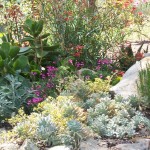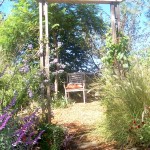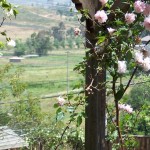Prompted by the rising water cost and irrigation restrictions, San Diego homeowners consult the many resources available the Water Conservation Garden in El Cajon (at www.thegarden.org ). Among these resources are landscape design and horticulture experts offering consultations on subjects like “California Friendly Plants”, watering, arboriculture (the science concerned with trees), construction issues and landscape design. I enjoy being one of those professionals, and I thought you might be curious to learn how such a consultation might work for the people that come there.
 In my consultations I generally encounter the same objective: Feeling the need to reduce their water bill or wanting a landscape that is more practical and ecological, these homeowners are ready to retire their mostly lawn-centered landscape. They come to the Water Conservation Garden with the common question, “What do I plant now?” Most of them believe that planting the right plants would make their gardens better and solve their problems; isn’t that what the beautiful low-water-use plants at “The Garden” are all about?
In my consultations I generally encounter the same objective: Feeling the need to reduce their water bill or wanting a landscape that is more practical and ecological, these homeowners are ready to retire their mostly lawn-centered landscape. They come to the Water Conservation Garden with the common question, “What do I plant now?” Most of them believe that planting the right plants would make their gardens better and solve their problems; isn’t that what the beautiful low-water-use plants at “The Garden” are all about?
I understand this thinking but, as designer and horticulturist, I don’t think that suggesting different, albeit drought resistant, water-wise or “xeric” plants, would address the underlying problem (although those plants are generally more sustainable). I feel that planting random groups of plants into the former lawn area would not create attractive, comfortable spaces for outdoor living that “work”. Since that is my focus, I explain to the visitors that it would serve them best if they considered first how to make enjoyable outdoor living possible, in separate spaces designed for different uses.
What needs to happen in a yard so it can become an “outdoor living room”? How do you convert it into a play room, or entertainment space, a space to hang out, relax, dream, rejuvenate?
A garden space needs to be organized spatially and hierarchically, and I start my design process, in which I involve my visitors, by asking them if they can think of an activity that they would like to do but never had room for or that was relegated to a back corner of their garden. Perhaps there is some almost forgotten vision of a garden scene in the recesses of their memory that they never took seriously? Take the example of my last visitors at the Garden:
This family, husband, wife and son, arrived well prepared for the consultation, with photos and a sketch of their garden drawn to scale. They had decided to take out most of the lawn, a large expanse right by the patio; they would only keep a small part of it for their son for whom lawn mowing is a therapeutic activity. Opposite the patio, far across the lawn, was a planter bed, but since it was so far away and confined also by a low wall, the flowers in it were not recognizable from the patio. To my surprise, the lady told me that it held roses! Her husband mentioned, almost in passing, that he would like to grow succulents. Some trees were there, but they had been planted around the louter perimeter of the lawn so that they couldn’t throw any shade where it mattered most, which was on their hot south-west facing patio.
“Hardscaping” elements such as patios, walk ways, fencing, arbors, boulders – convey permanence and add structure. Most of them don’t have to be maintained, except for some new coat of paint or occasional sweeping, depending on the material used. And they don’t demand watering, fertilization, pruning… So I suggest to incorporate them as much as possible into a design and let them “furnish” the garden, organize the space into areas of different use, provide separation as well as access, focal points, delineation and definition.
In the case of the before mentioned visitors, we found that a swing for adults, placed under a shade tree, would be lovely to have; I suggested to place it at the far end of the garden from where the family could see house and patio from a new perspective, and I drew its outlines on transparent paper taped over their sketch. And why not pull rose bed and succulents closer to the patio from where they could be seen? Of course not into one flower bed, but in different areas that are perhaps even mounded up, separated by a walk way: Gently curved mounds give movement to an otherwise flat plan, and the plants on them can be seen better, like on a painted canvas. And if your soil drains poorly, creating those mounds helps improve the drainage because you can mix the mounded soil to provide the drainage your plants need, such as many Mediterranean plants, California Natives and succulents, and even roses.
As for the lawn, we drew a much reduced kidney-shaped area that started at one end of the patio, wrapped around behind the rose bed and the succulent mound, and ended at the other end of the patio. This way it was still visible and easy to get to from the patio without dominating the foreground. And to make all the different areas accessible, we discussed stepping stones and DG as possible material for the walkways, even coarse landscape mulch was considered.
Lastly we reviewed the possible locations of trees, and I pointed to my most favorite reference books on this subject: Ornamental Trees for a Mediterranean Climate, the trees of San Diego, by Steve Brigham with book design and photographs by Don Walker, and the Sunset Western Garden Book. Here gardeners can research all their favorite choices before making the final selection; they can actually visit the trees shown in the tree book at their location!
Our time was up, and although we had not talked much about plants in detail, the family was happy (I suggested to look to the Water Conservation Garden’s displays for ideas). Both husband and wife had information and tools in their hands that will make “playing” with their spaces, on paper first, a fun and exciting activity; selecting goals that are realistic and achievable with their budget and energy will now be a manageable task. And finally, armed with the proper reference books and resources that the Water Conservation Garden and other public gardens in San Diego County offer, they will be on their way to a garden that they can enjoy, and live in.


